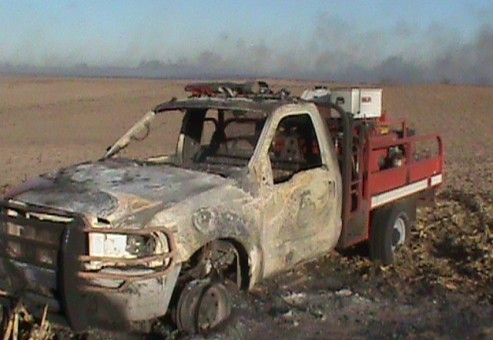
UPDATE @ 1:45 p.m. MT, November 10
The Antelope fire was 100 percent contained yesterday afternoon. There was no update from the State on the number of bonus acres burned outside the control lines.
=====================
UPDATE @ 12:15 p.m. MT, November 9
Information from the South Dakota Wildland Fire Suppression Division is very difficult to obtain, but the Rapid City Journal is reporting that Incident Commander Joe Lowe said, “Hand crews and engines worked extremely hard throughout the night to stop the forward progress of the fire. They did an exemplarily job.”
The fire has burned 75 acres and is now 90 percent contained.
The weather forecast for the fire area predicts winds of 15 mph with gusts up to 23 on Tuesday afternoon. There is an 8% to 32% chance of 0.03″ of rain, or 0.2″ of snow through Tuesday night.
========================
(From November 8, 2010)
A prescribed fire in Custer State Park southwest of Rapid City, South Dakota burned at least 60 acres outside the project boundaries on Monday.
Crews ignited the prescribed fire at 11 a.m. but pushed by winds stronger than expected, it crossed the containment lines before noon. By 3 p.m. it had burned 60 acres outside the lines and acquired the name Antelope Fire. At that time it was 25% contained.
At 11:35 a.m. to noon on Monday, weather stations at Elk Mountain and Custer State Park Airstrip recorded average wind speeds of 11 and 9 mph, respectively, with gusts to 20 and 26. The relative humidity was 20% and 18%.
Beth Hermanson, a spokesperson for the state’s Wildland Fire Suppression Division, said firefighters are hoping that a cold front moving into the area Monday night will help the 100 people working to control the fire.
The weather forecast for Monday night for the fire area is for temperatures to fall to 41 degrees, a relative humidity maximum of 73%, and south winds of 6 increasing to 15. For Tuesday, there is a 20% chance of receiving 0.01″ of rain in the morning, with a 53% chance of 0.02″ of rain in the afternoon. The minimum RH will be 54%. Winds should be 14-16 out of the south, with gusts to 23. Tuesday night there is a 34% chance of 0.4″ of snow.
Here is a link to some video shot by KELO, apparently before the fire escaped. Ironically, the title of the KELO article is A Fire That Gives Back, referring to the natural resource benefits of prescribed fire, of which there are many. But some gifts you WANT to give back, at least if it includes acres burned outside the project boundary.
Here is another link to a video report about the escaped fire, from Blackhills Fox.


